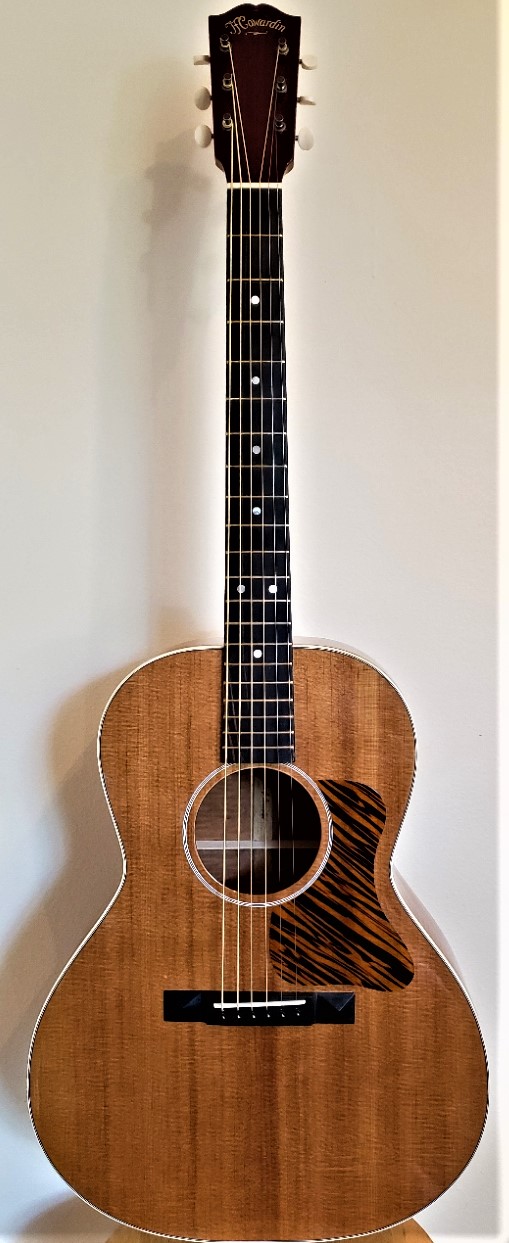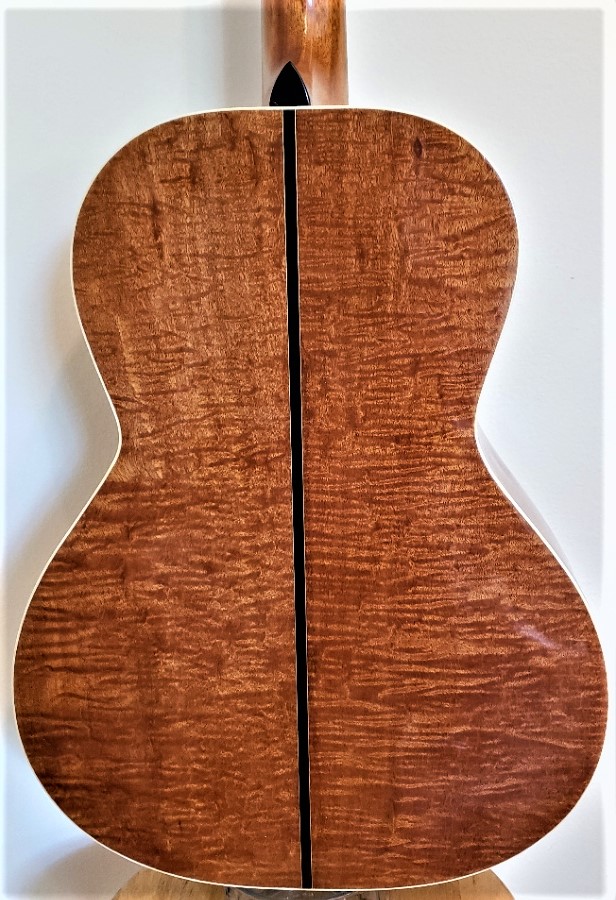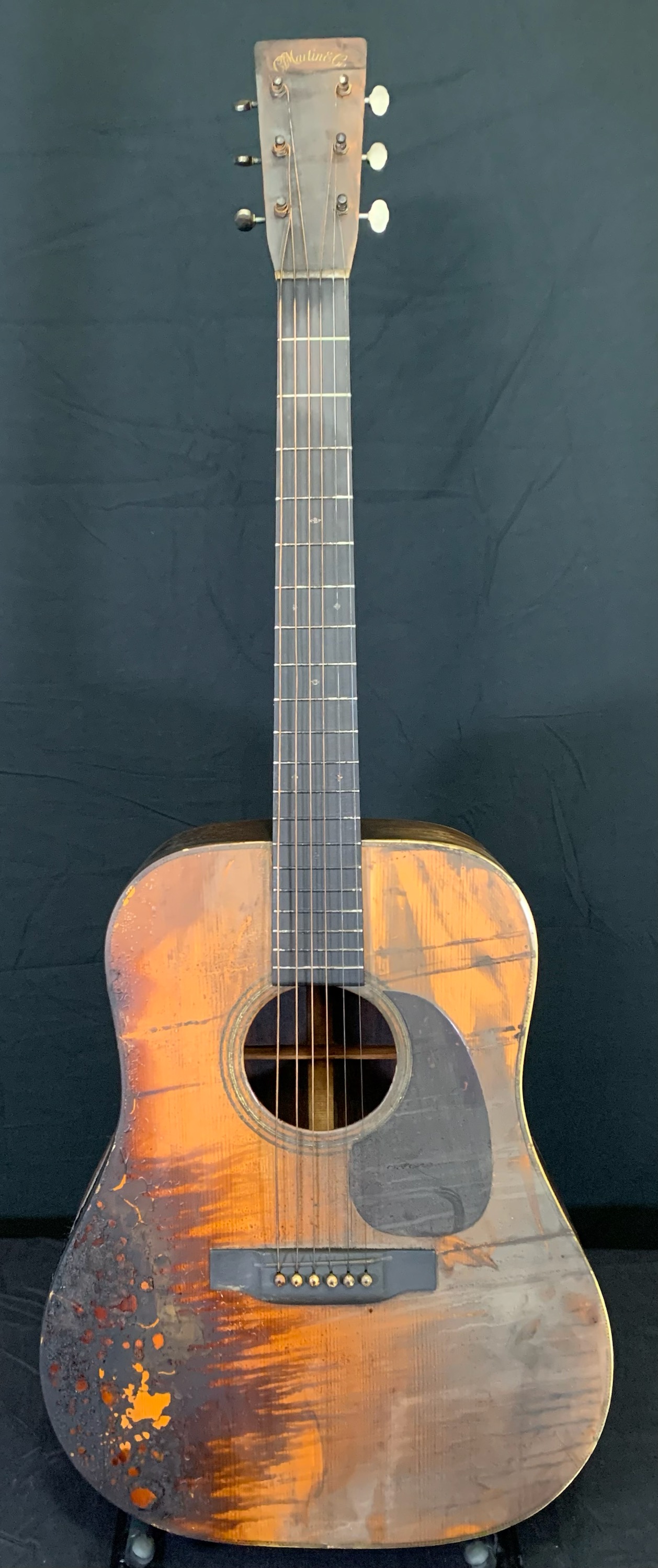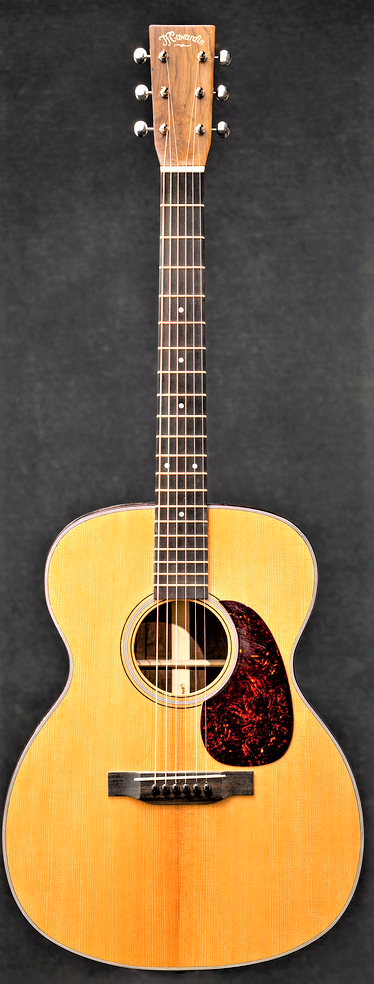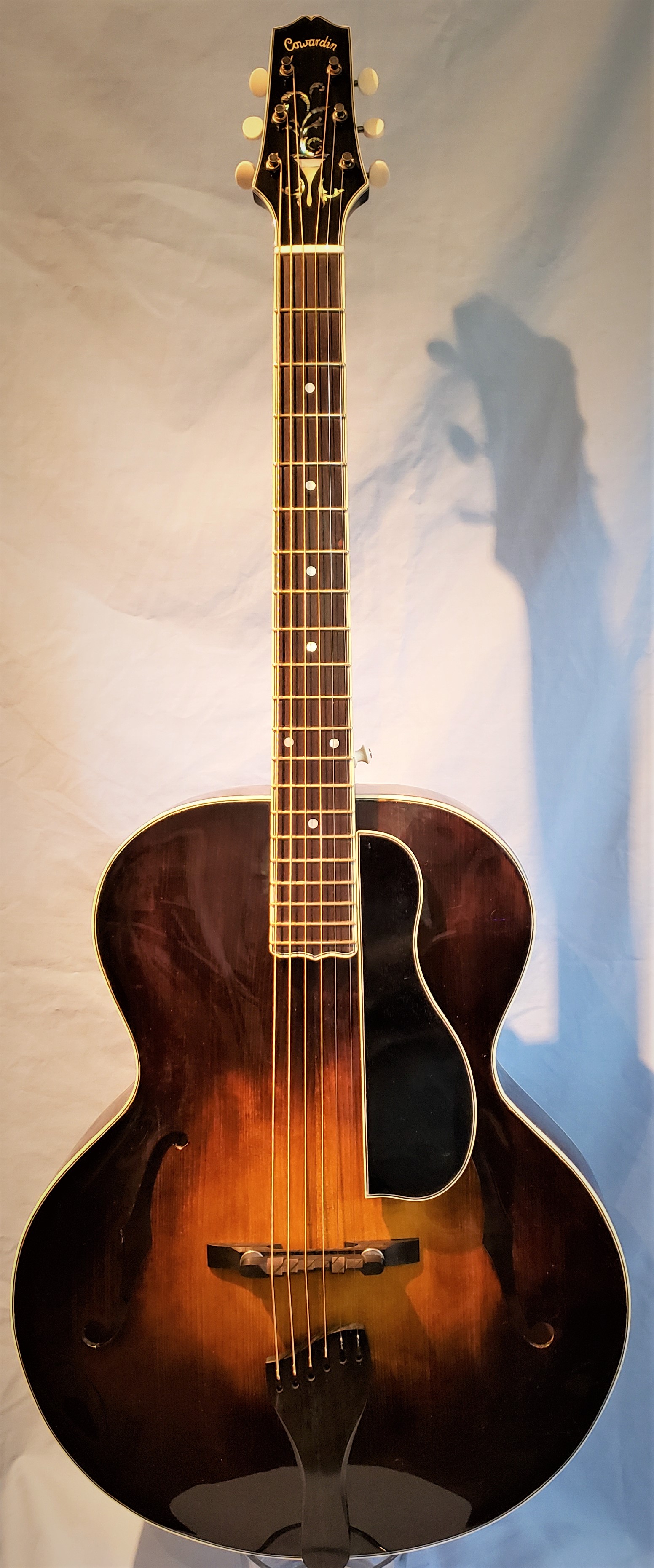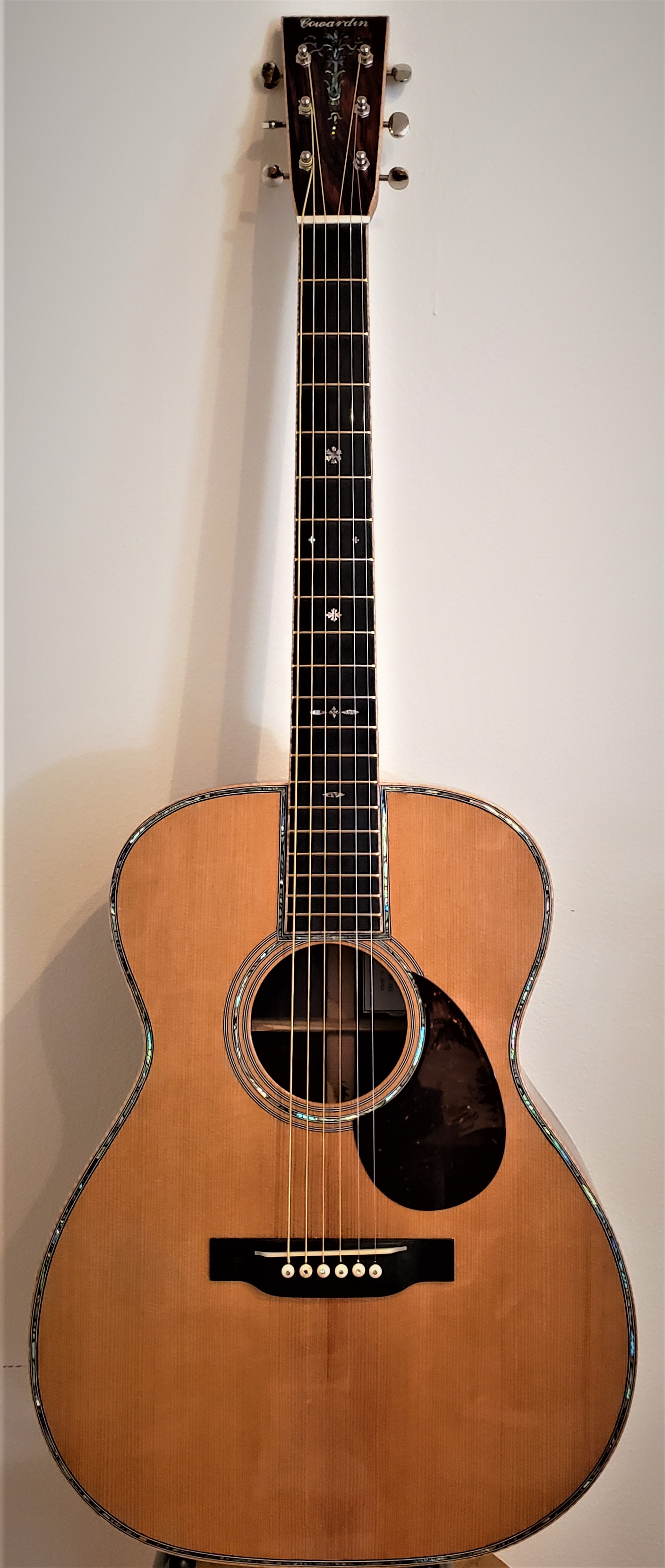The type of wood chosen for a custom guitar is a major factor contributing to tone. Only quality construction and design have more effect.
There are many varieties of woods to choose from. Below are many different woods with descriptions of their general tonal properties.
TONE WOODS for SOUNDBOARDS
Sitka Spruce
(Picea Sitchensis) Canadian Northwest & Alaska.
Sitka spruce is the most widely used wood for soundboards of modern guitars such as Martin, Gibson, Taylor and others. It is a large tree and provides consistent quality and straight uniform grain. Sitka is has a high stiffness to weight ratio providing an ideal diaphragm for transmission of sound on any size and style of stringed instrument. Old Sitka Spruce often darkens, sometimes to a brown-orange color, as it oxidizes over time.
Bear Claw Sitka Spruce is a specifically named variety of Sitka Spruce that exhibits a random figure due to genetic or environmental factors. It looks like a bear has clawed across the grain of the wood. This particular variety is highly coveted for it's unique patterns.
Engelmann Spruce
(Picea Engelmannii) Western United States.
Englemann spruce is similar in color to European (German) White spruce. It is a softer Spruce than either Sirtka or Adirondack. It is lighter ightness in weight and produces a deeper tone sound than Sitka spruce. Englemann spruce grows in the alpine elevations of the American Rocky Mountains and the Pacific Cascades. It is considerably more limited in supply than Sitka spruce.
Adirondack (Red) Spruce
(Picea Rubens) Eastern United States.
This legendary wood that Martin used for its tops prior to 1945 came from the East Coast, from the Southern Mountains into New England and upper New York State. Called both Appalachian and Adirondack spruce, it has a creamy white color. Red Spruce as the highest stiffness to weight ratio of the North American Spruce variants. The Red Spruce is a smaller tree than either Sitka or Engelmann, and does not often display the kind of straight and tight grain found in Sitka. Adirondack has been less available since the mid-1940's, but has been sought after in recent years and so can usually be found. There is often an extra charge for Adirondack Spruce.
Red Spruce ages to a golden yellow color as it ages.
European, Alpine, Italian, Carpathian Spruces
Picea Excelsa or Picea Abies,
Alpine Italian Spruce
This legendary wood that Stradivarius used for his violins is a great wood for soundboards, but very hard to come by, and very expensive when found. Italian Spruce has always been used in the Italian traditional violin making and originates from the North Eastern area of the Italian Alps. The trees grow at high altitude, from 1400 up to 1800 meters and the growth period is only 100 days a year. The winters are long and cold, so the trees grow slowly and regularly. The time required to grow a tree large enough to provide a violin or guitar log is 150 to 200 years, and even more for a cello log. This wood is very stiff and light: 400 kg/m3 as some studies have established. The average size of the Italian Spruce is much smaller and less regular than others kinds of Spruce, like Sitka Spruce for example. European Spruce is often very expensive in the USA.
Carpathian Spruce
From the Caucasus and Carpathian mountains that surround the Black sea
This wood has a very creamy, white appearance but with slightly wider grain than the other European Spruces. These tops are quite stiff and offer a slightly brighter, glassier tap tone than the other European Spruces. Many have compared it to Adirondack Spruce and some even call it ‘Carpathian Red Spruce’. It is slightly less expensive than the other European Spruces and widely available.
German Spruce
Picea excelsa, Picea abies
A highly regarded tone wood. German spruce is a common term for spruce coming from Europe. Guitar grade Spruce does not come from Germany anymore. The best material these days is found in the former Yugoslavia region. When you order ‘German Spruce’ these days, you can expect a excellent, slightly golden-colored tone wood that is a favorite among high-end steel string and classical guitar builders.
Redwood
A great choice for the fingerstylist with somewhat more richness in the bass than cedar. Redwood responds to subtle playing with a crisp balanced sound. The bass response is particularly round and full with a piano-like crispness. Lacquer and glue do not bond quite as well as the spruces. Originally from Northern California, many luthiers get redwood from recycled lumber and timber salvage.
Western Red Cedar
Thuja Plicata
United States, particularly the Pacific Northwest.
Western Red Cedar has long been utilized as a soundboard material by classical guitar makers for its vibrance and clarity of sound. It is extremely light in weight compared to spruce and the tonal result is generally a slightly louder, more open response. Balanced, warm and rich with bright trebles. What is most characteristic of Red Cedar is that it sounds broken-in even when new. Exceptional sound for light to very firm techniques. Coloration runs from light (almost as light as Sitka) to a very dark reddish-brown.
Hawaiian Koa
Acacia Koa
Hawaii. Historically, koa tops have appeared primarily on small bodied 0 & 00 size Hawaiian guitars and ukuleles although recent koa Dreadnoughts and custom guitars have been popular. Koa produces a predominately bright treble response with less volume than spruce, but the slight loss in volume is overshadowed by the extreme beauty of the grain. Koa tops are available on special order and custom instruments.
Genuine Mahogany
Swietenia Macrophylla
Central America, Belize south to Brazil.
Mahogany has been used on Martin Style 17 guitars. During World War II, some Gibson guitars were made with Mahogany Tops. Mahogany producies a subdued response that is crisp and delicate with emphasis on the mid-range.
TONE WOODS for BACK & SIDES
Brazilian Rosewood
Dalbergia Nigra Brazil.
Sometimes referred to as "Jacaranda", this species of genuine rosewood ranges in color from dark brown to violet with spidery black streaks. The smell is like roses when freshly cut. Brazilian rosewood is quite expensive if it can be found. Brazilian Rosewood is resonant producing full, deep basses and brilliant trebles. The kind of quarter sawn old growth Brazilian found in vintage Martin guitars is rarely found today. The price for Brazilian Rosewood is very high, and prices are at a premium for guitars made from this wood.
Bubinga (Guibourtia spp. (G. demeusei, G. pellegriniana, G. tessmannii)) - Equatorial Africa
An immensely popular imported African hardwood, Bubinga may be loved as much for its quirky name as it is for its strength and beauty. Also sometimes called Kevazingo, usually in reference to its decorative rotary-cut veneer. Bubinga has a close resemblance to rosewood, and is often use in place of more expensive woods. Yet Bubinga also features a host of stunning grain figures, such as flamed, pommele, and waterfall, which make this wood truly unique. Bubinga also has an exceptional strength-to-weight ratio.
Madagascar Rosewood(Dalbergia Baroni) - Madagascar.
There are several varieties of Dalbergia Baroni, Madagascar Rosewood or Voamboana, milled in Madagascar. The only wood almost similar in appearance and sound to Brazilian Rosewood. This wood has all of the best attributes of the old Brazilian Rosewood – brilliant, deep colors (red/orange, red/brown, brown, purple/brown) with intense black line patterning, clear ringing tap tone, easy to bend and work. Unfortunately, very hard to come by. The price is moderately high. Highly recommended as one of the best available Tone woods.
Cocobolo Rosewood
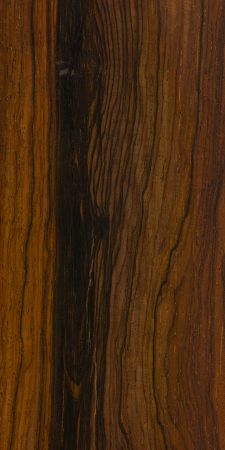
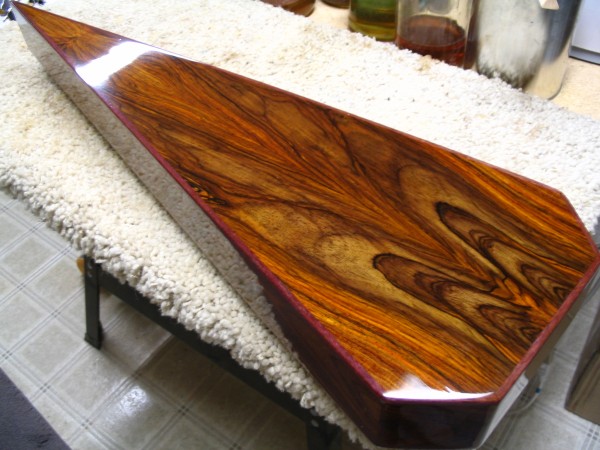
Cocobolo is a hardwood from Central America yielded by two to four closely related species of the genus Dalbergia. The best known species is Dalbergia retusa, a fair-sized tree, reported to reach 20-25 m in height. Because of its great beauty and high value, this species has been heavily exploited and the tree is now in danger of extinction outside of national parks, reserves and plantations. Cocobolo is a very beautiful wood, known to change color after being cut. It is typically orange or reddish-brown in color, often with a figuring of darker irregular traces weaving through the wood. Cocobolo is a exceptionally fine Tone wood, close to Madagascar in Tone Quality.
Reports indicate that Cocobolo is stronger and denser than Brazilian Rosewood
East Indian Rosewood (Dalbergia Latifolia) India.
Typically richly grained with dark purple, red, and brown color, East Indian rosewood is resinous, stable and generally more consistent than most other rosewood species. East Indian rosewood is extremely resonant producing a deep warm projective bass response that is especially accentuated on large bodies guitars.
o Dalbergia latifolia is typically richly grained with dark purple, red, and brown color.
o Dalbergia sissoo is similar to latifolia except the shades tend more towards red than purple.
Genuine (Honduran) Mahogany
(Swietenia Macrophylla) Brazil. Yellowish brown to reddish brown in color, Genuine or "Amazon" mahogany is exceptionally stable and consistently clear. Honduran Mahogany is much lighter in weight than rosewood, koa, or maple. In spite of its weight, mahogany yields a surprisingly strong loud sound with an emphasis on clear bright trebles. By tradition (Martin) used for Cheaper guitars, Mahogany doesn’t deserve this. Selected Mahogany is a Thrilling Tone wood.
Cuban Mahogany (Swietenia mahogani) from the Caribbean.
Cuban mahogany is very similar to mahogany from mainland South America in appearance except it tends towards reddish brown in color. Cuban mahogany is denser than Swietenia macrophylla and the texture is much finer. Woodworkers often compare Cuban mahogany to silk and Honduran mahogany to burlap. But like Brazilian Rosewood it is banned in 1946 and hard to come by. The tone is similar to Honduran Mahogany with, some feel, a better treble response.
Figured Mahogany
This beautiful and rare (often quilted) variety of genuine mahogany occurs in a very small percentage of mahogany trees. Though difficult to bend, figured mahogany shares the same tonal properties of the unfigured mahogany except.
European Flamed Maple (Acer Campestre) Germany.
Curly maple, fiddleback maple, tiger maple, flamed maple, rippled mapleNot a distinct species of maple. Curly maple is considered a grain pattern that can be found in nearly all Acer species.
Not a distinct species of maple. Curly maple is considered a grain pattern that can be found in nearly all Acer species.
Called curly maple because the ripples in the grain pattern create a three dimensional effect that appears as if the grain has “curled” along the length of the board. It’s also referred to as fiddleback maple, in reference to its historic use for the backs and sides of violins.
Curly maple figuring is similar to quilted maple, but curl is a primarily horizontal pattern perpendicular to the wood grain. Unlike quilted maple, curly maple is most pronounced when the board is quartersawn, and the curls usually become much less pronounced or absent in flatsawn sections of boards. It is not completely clear what environmental conditions (if any) cause this phenomenon, but there are different grades of curly maple, which greatly affect its price.
maple refers to the characteristic alternating hard and soft rippling which runs perpendicular to the grain in some rarer maple trees. This particular species of European maple is very hard and reflective, producing a loud powerful projective sound.
Hard Maple - Sugar Maple (Acer campestre)Northern America.
It is very similar to European maple, although the figure in the wood can be different. "Birdseye" maple is a variant with tiny whorles that resemble eyes.
Eastern Red Maple
Red maple is appropriately named, as its flowers, twigs, seeds, and autumn leaves (shown below) are all red. Red maple is common over a very large area of the eastern Untied States, and its wood tends to be slightly heavier, stronger, and harder than other species in the grouping of soft maples, though it is still not as strong as hard maple. Moderately priced, though figured pieces such as curly or quilted grain patterns are likely to be much more expensive.
Hawaiian Koa (Acacia Koa) Hawaii.
Golden brown color with dark streaks and a lustrous sheen. Koa wood occasionally develops a curly or flamed figure. Regardless of any figuring, koa seems to have a bass response that is slightly less than that of rosewood and treble response that is slightly less than that of mahogany. The result is a very equally balanced instrument.
Walnut
A great selection with bright woodiness of mahogany when played lightly, with much of the punchiness and power of rosewood when you dig in. When properly braced, a walnut backed guitar can have a unique warmth and tonal depth. This is a dark brown, highly figured specialty wood which is grown in a wide variety of locations.
Morado
(Machaerium Scleroxylon) Bolivia. Also known as Bolivian or Santos "rosewood", morado ranges in color from a light violet brown to reddish brown with occasional olive and black streaks. Finer in texture than most rosewoods, morado is a close visual substitute for East Indian rosewood, and has very similar tonal properties.
Myrtlewood
The best way to describe Myrtlewood is that it has the powerful voice of rosewood coupled with all the clarity, brightness and balance of maple. Myrtlewood can be found in the coastal mountain regions of northern California and southern Oregon. With coloration anywhere from an elegant whitish/straight grained look (a blonde mahogany), to yellow/green with flame, the tonal personality of Myrtlewood is consistent. Use of this wood on a guitar was first done by Breedlove and is featured on the Breedlove "Northwest" guitar. Prior to this, using Myrtlewood to build a guitar has never been done.
Striped Ebony
Deeper and richer sounding than East Indian Rosewood, many would characterize striped ebony as very similar to Brazilian rosewood, but I feel it is structurally different. It is dense, has similar reflective properties to Brazilian, and it also has a high specific gravity. It is probably one of the most beautiful Tone woods cosmetically. It has a striking, distinctive vertical stripe pattern, variegated dark brown, black and green. It makes a truly exceptional twelve-string. Striped ebony comes from New Guinea, is exclusively government controlled, and is not an endangered species.
Cherry
With a density and reflectivity approaching that of maple, cherry produces a rich, projective midrange and balance without favoring the bass or treble frequencies.
Tone Woods For SOLID BODY Electrics
White Ash
The tonal character of ash issurprisingly loud and bright, with a strong midrange and a crisp bass. White Ash has a "snappy" loud tone with a bright edge, but with a warm bass and long sustain. It is more aggressive sounding than alder. Ash is considered as the "traditional" Fender Telecaster body wood. The tonal character of ash is surprisingly loud and bright, with a strong midrange and a crisp bass. Ash is not used very often for acoustic guitars Swamp Ash is the
White ash from the Swamps, can be extremely light of weight or extremely heavy. Has similar tone qualities as White ash. Normally used for Solid body guitars only but white Ash was utilized on a limited but extremely popular run of D-16A Martin guitars made between 1987 and 1990! The tonal character of ash surprisingly loud and bright, with a strong midrange and a crisp bass.
Alder (Alnus spp.)
has a full and rich sound with a fat low end and nice cutting mids, and good overall warmth and sustain. It has less bite and lesser highs than ash. Alder is the most common body woods used by Fender and is usually found in Stratocasters.
Poplar (Populus spp.).
One of the softer hardwoods, nicely resonant with a meaty tone. This wood is being used by many electric guitar manufacturers as a substitute for alder as it is quite similar in tone.
Basswood.
The principal wood used on most Japanese made instruments since it is the best available tonewood in Asia, although customer demand made the Japanese builders turn more to ash since 2004. It is a very light wood but it also isn't very sturdy and has no real grain. Its tonal response is very similar to alder.
Mahogany
Various Mahogany species are used for electric guitar bodies. Honduran and African Mahogany most widely, but also variants such as Sapele, Khaya, Sipo and others. Mahoganies tend to be a bit heavier that Alder, Swamp Ash, or Basswood.
Narra
Walnut and other domestic hardwoods.

